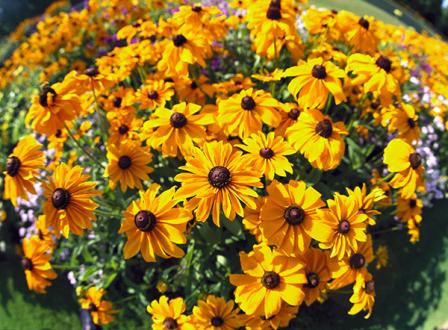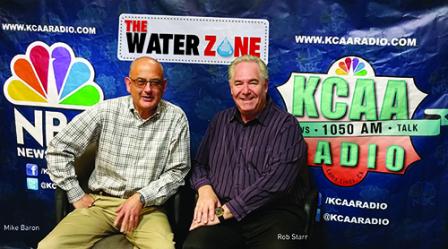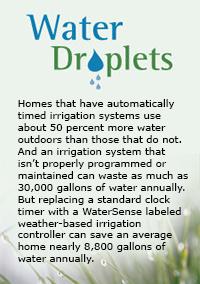The WaterSense Current: Spring 2016

Issue XXXVIII
Celebrate the 46th Earth Day by Saving Water
This April 22nd marks the 46th anniversary of Earth Day, and what better way to celebrate than saving water in the great outdoors? You can get started with some of the outdoor water-saving tips below while you reconnect with nature and give back to the earth by saving water in your lawn or garden this spring.
 Here are six simple tips to preserve this precious resource:
Here are six simple tips to preserve this precious resource:
- Check the time: Water your yard in the morning or evening to avoid losing water to evaporation in the heat of the day.
- Get in the “hydro” zone: Group the plants in your garden according to their water needs, also known as using “hydrozones,” which reduce the risk of over watering your plants.
- Use mulch: Adding mulch in your garden helps reduce evaporation, inhibit weed growth, moderate soil temperature, and prevent erosion.
- Keep control: Upgrade to a WaterSense labeled controller, which acts like a thermostat for your sprinkler system using actual local weather conditions to tailor your watering schedule.
- Compost: Instead of sending organic waste from your kitchen down the garbage disposal with water, add them to a compost pile. You can then use the compost as nutrient-rich soil to add to your garden.
- Commit to save water! Take the “I’m for Water” pledge and use the 2016 monthly resolutions checklist(2 pp, 87 K, About PDF) to extend your Earth Day water conservation to a year-round effort.
Can you do four or six of these to celebrate the 46th Earth Day? Or find more tips on WaterSense’s “Start Saving” page.
WaterSense Partners Help Consumers Catch Leaks
 Did you know in just 10 minutes, you can detect household leaks that could be robbing your home of more than 10,000 gallons of water per year? WaterSense partners encouraged consumers to become leak detectives during the eighth annual Fix a Leak Week (March 14 to 20, 2016) sponsored by EPA. To celebrate, WaterSense partners across the country hosted events to help consumers learn how to track down and fix common household leaks. Here are a few of them:
Did you know in just 10 minutes, you can detect household leaks that could be robbing your home of more than 10,000 gallons of water per year? WaterSense partners encouraged consumers to become leak detectives during the eighth annual Fix a Leak Week (March 14 to 20, 2016) sponsored by EPA. To celebrate, WaterSense partners across the country hosted events to help consumers learn how to track down and fix common household leaks. Here are a few of them:
Milwaukee Students Get Schooled in Leak Detection: The Milwaukee Metropolitan Sewerage District (MMSD) in Wisconsin recruited nearly 1,300 students to become leak detectives at home and at school. Speakers from MMSD presented to 40 classes and provided teachers with lesson plans, leak detection tablets, water conservation exercises, and drip calculators. Students presented their findings to their teachers, and MMSD rewarded qualifying classes with a one-day field trip to Discovery World Science and Technology Center in Milwaukee. MMSD also encouraged students to submit art or essays on water conservation for a chance to win one of 10 year-long family memberships to a local nature center or Discovery World.
Texas Partners Help Lasso Leaks in the Lone Star State: Tarrant Regional Water District in Fort Worth, Texas, partnered with local and regional water providers and coordinated with The Home Depot to provide free, one-day Fix a Leak Week workshops on March 19. The workshops focused on repairing leaks in three different types of fixtures: faucets, toilets, and sprinkler heads. Workshops were hosted by Home Depot stores in Tarrant, Dallas, Collin, Cooke, Denton, Ellis, Grayson, Hood, Hunt, Johnson, Kaufman, Navarro, Parker, Rockwall, and Wichita counties.
Goodyear Gets Leak-Fixers Into the Game: The city of Goodyear, Arizona, challenged its residents to fix leaks and make other changes to use less than 3,000 gallons of water for the whole year in exchange for a prize. The Cincinnati Reds and Cleveland Indians, who train at the Goodyear Ballpark Complex, offered households who registered and successfully completed this challenge complementary tickets to a spring training baseball game.
Arizona Captures Creative Water-Savings Captions: Phoenix, Arizona, hosted a social media contest called the #FixALeakWeek caption challenge. The city posted a series of photographs of a #SmartPig, and the leak related caption with the most likes for each photograph received a reusable City of Phoenix water bottle.
Check out the EPA WaterSense Facebook map Exitto find Fix a Leak Week events that happened in your area. The good news is, fixing leaks isn’t limited to one week in March. With this checklist(2 pp, 201 K, About PDF) you can track down leaks all year, both inside and out.
The Right Plant in the Right Place Is the Path to a Water-Smart Garden
Go back to your roots when you’re thinking about saving water this spring. With varying climates and geography nationwide, each region has distinctive plant species it can naturally support without requiring extra water and fertilizers. When you’re planning your garden this spring, use WaterSense’s What to Plant tool to help you choose plants that are right for your climate and require minimal watering. Then group your plants in “hydrozones” according to their water needs to make it easy to irrigate them correctly.
Across the country, gardeners are already digging into the right plant, right place concept. You can find examples in the U.S. Northeast, Midwest, Southeast regions below, as well as nationwide in EPA’s water-smart landscape photo gallery.
Northwest
The garden pictured on the right in Olympia, Washington, includes plants that can tolerate drought and heavy rains. While the landscape can survive with little rain, it can also capture stormwater from roofs, driveways, and sidewalks. Plants in this garden include grosso lavender, red herbaceous peony, sunshine blue blueberries, creeping red thyme, and penstemon rondo.
Midwest
This garden in Ann Arbor, Michigan, includes native plants to help absorb stormwater runoff. Using a conduit installed in the curb, stormwater is diverted from the street and into the rain garden. Plants used in this garden include blue cardinal flowers, rose milkweed, trumpetweed, and boneset.
Southeast
The garden shown at right in Bristol, Tennessee, was formerly a turf grass lawn. In order to manage rain and runoff the area receives, native wildflowers and grasses were included to match to the site’s water conditions, reducing the need for irrigation. Plants in this garden include anise hyssop, serviceberry, sweetbay magnolia, wild bergamot, and summer phlox.
Read other water-smart landscape design tips from WaterSense to maintain a healthy yard while using less water.
Add Sprinkler Spruce-Up to Your Spring Cleaning List
Experts estimate that as much as half of the water we use outdoors is lost due to evaporation, wind, or runoff caused by inefficient irrigation methods and systems. Before you add water to your newly planted garden this spring, do a little “sprinkler spruce-up” to clean up on water savings outdoors. It just takes four simple steps: inspect, connect, direct, and select.
- Inspect your system for clogged, broken or missing sprinkler heads.
- Connect points where the sprinkler heads connect to pipes and hoses. If water pools in your landscape or you have large soggy areas, you could have a leak in your system. A leak about as small as the tip of a ballpoint pen (or 1/32nd of an inch) can waste about 6,300 gallons of water per month.
- Direct sprinklers away from your driveway, house, or sidewalk in order to apply water only to your landscape.
- Select a seasonally appropriate watering schedule that meets your landscape’s minimum needs. Better yet, select a WaterSense labeled irrigation controller—which uses local weather data so your system waters only when necessary—to replace a traditional clock-timer scheduling system.
Not the do-it-yourself type? Go with a pro—a professional certified by a WaterSense labeled program. Check out this list to find one!
The Toro Company Spreads the Word on Outdoor Water Savings
Since becoming one of the first major manufacturers to earn the WaterSense label for weather-based irrigation controllers, The Toro Company has continued to sprinkle water savings across the country by partnering with water agencies, organizations, and regional Irrigation Association chapters to educate consumers on the benefits of weather-based irrigation controllers. Unlike clock-timed controllers, weather-based controllers act like a thermostat for your sprinkler system, cutting down water waste by using local weather data to apply water only when and how much landscapes need it.
 The Toro Company works with partners to educate consumers about installing and programming weather-based irrigation controllers, as well as available municipal rebates for WaterSense labeled controllers. Toro also focuses on training contractors throughout North America on water-saving behaviors, benefits of WaterSense labeled products, and best practices for installing and maintaining weather-based irrigation controllers to boost water savings.
The Toro Company works with partners to educate consumers about installing and programming weather-based irrigation controllers, as well as available municipal rebates for WaterSense labeled controllers. Toro also focuses on training contractors throughout North America on water-saving behaviors, benefits of WaterSense labeled products, and best practices for installing and maintaining weather-based irrigation controllers to boost water savings.
 In California, the Toro Company hosted multiple workshops in 2014 to show homeowners how to use the company’s weather-based irrigation controllers and weather sensors. In 2014, training events featuring WaterSense labeled products and efficient watering best practices reached nearly 3,000 homeowners and industry professionals. In addition, the company introduced “The Water Zone” weekly radio show to Southern California in 2014 as a forum for discussing California’s drought, with the aim of educating listeners on products and practices that could help save water outdoors.
In California, the Toro Company hosted multiple workshops in 2014 to show homeowners how to use the company’s weather-based irrigation controllers and weather sensors. In 2014, training events featuring WaterSense labeled products and efficient watering best practices reached nearly 3,000 homeowners and industry professionals. In addition, the company introduced “The Water Zone” weekly radio show to Southern California in 2014 as a forum for discussing California’s drought, with the aim of educating listeners on products and practices that could help save water outdoors.
For its demonstrated commitment to expanding awareness of WaterSense labeled products, The Toro Company earned the WaterSense 2015 Manufacturer Partner of the Year award. Learn more about The Toro Company’s efforts promote water-efficient irrigation technologies.

